People and
things don't last, but the mysteries of their passing can be
persistent...
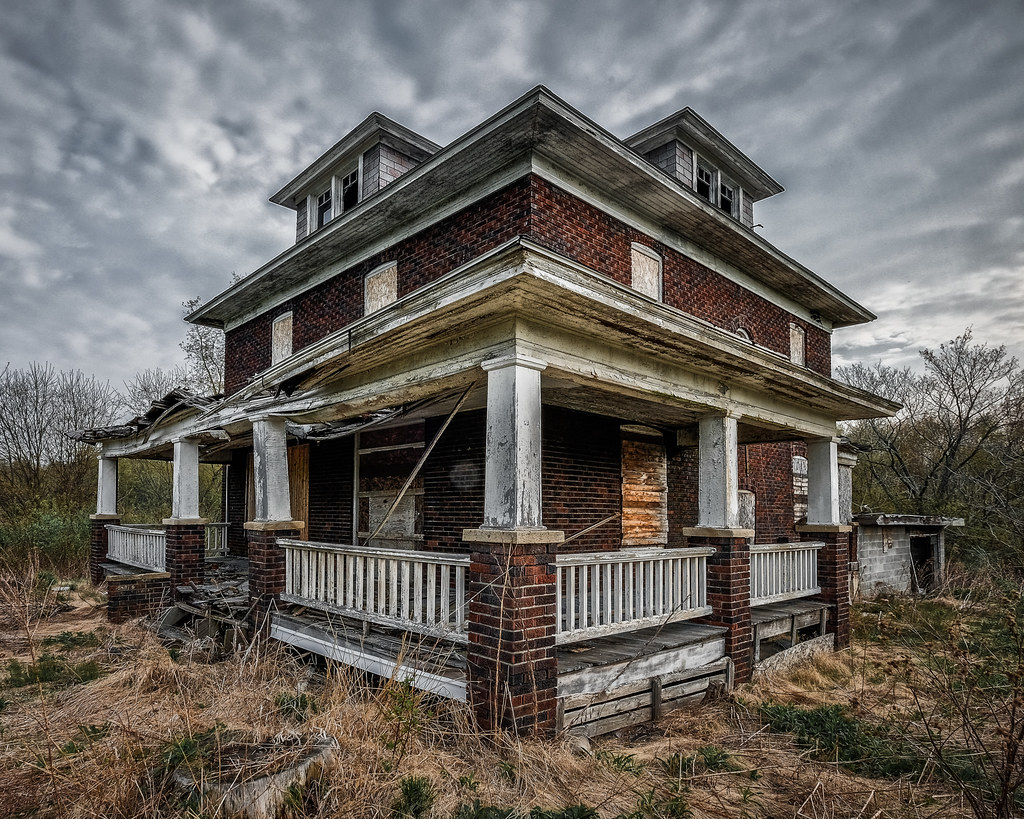
"Childhood
has its secrets and its mysteries; but who can tell or who can
explain them!" -- Max Muller
Posted May
16, 2015
The
Genesis of a Fascination
I grew up
as a young boy just outside a very small village founded in the
1600's by Quakers. The place was (and still is) called Crosswicks,
New Jersey. At the time it was a town of perhaps 300 to 500 or so
people, surrounded by farms, and it was quite rural indeed.

Modern
sign commemorating the village – something that was not there
when I was growing up.
At some
point when I was 12 or 13 years old (around 1967) I was drawn to a
modest house outside of town, hidden in trees and overgrowth, that
some of the local kids described as “haunted”. It was
definitely not in use, the yard overgrown, and a broad open carriage
house behind it filled with gloriously rusted antique bicycles. In those days, it was not so common for kids
to break the windows of abandoned properties and litter it with
graffiti like you almost always see these days. This place was
completely intact, but long abandoned.
But more
compelling was that on looking through the dirty windows, one could
see the house was fully furnished – in the kitchen clean but
dusty dishes were in the drainboard. Pictures were hung on the
walls and throw rugs on the hardwood floor.
A mystery
of a high order to the adventurous young man I was.

Main Steet in Crosswicks -- originally built on a winding Indian path.
I found an
unlocked window and entered the dim environment. No ghosts met me
there, or at least none of the “Hollywood style” ones –
though the place was in a sense “haunted”. It was
haunted by the signs of the life that had been lived there.
Rural
Exploration
Back
then I was photographing things with slow slide film and a very
modest camera but I had no thought to photograph this place... sadly.
But I did explore it thorougly taking with me only an interesting
book on card tricks I found in the attic. I can still do a few of
them.
But
something that fascinated me was the photos on the walls. So much
that I can still see them in my minds eye. In later life this
experience inspired a poem of mine that opened:
Faded pictures under cloudy glass
In a hall where the light is low
Memories that recall the past
Of a place that nobody knows
People
neither spoke of this place nor seemed to have any knowledge of it.
It was not for sale. It was a mystery. Of the folks I asked about
it I told none of them that I had been inside it.
I
think this one experience was the beginning my fascination with
abandoned places.
A Chance
Find, The Need to Know
The
opening photo in this set is from a recent find in very rural western
PA where I was commissioning a propane pumping station on an NGL
(natural gas liquid) pipeline system. It was located immediately
adjacent to the already very out-of-the-way pumping station. I saw
the house and on a morning when we were starting late I went early to
see if there was anything there worth photographing – and got
quite the surprise.
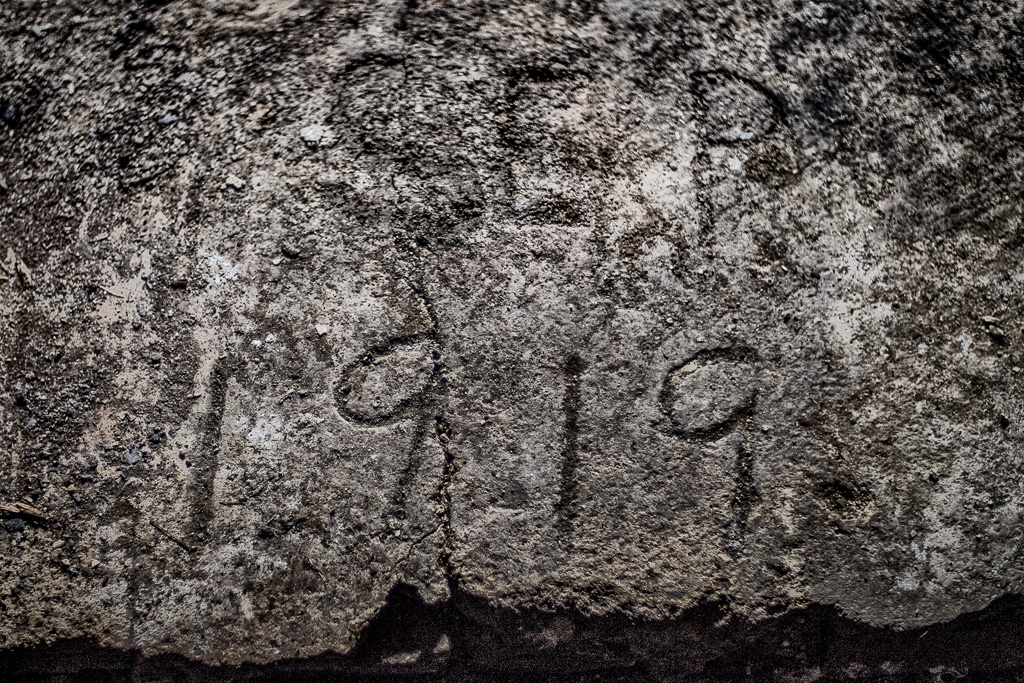
Not quite 100 years old.
Kids
and “scrappers” (people that invade abandoned properties
to steal anything worthwhile – mostly copper piping and wiring)
had broken into the basement from the doorway in back of the house.
But for all that the house was still full of the family's things and
that is an amazing find these days.
Coming
into the basement over the crumbling threshold of the broken door was
immediate evidence that the home had not been “cleaned out”.
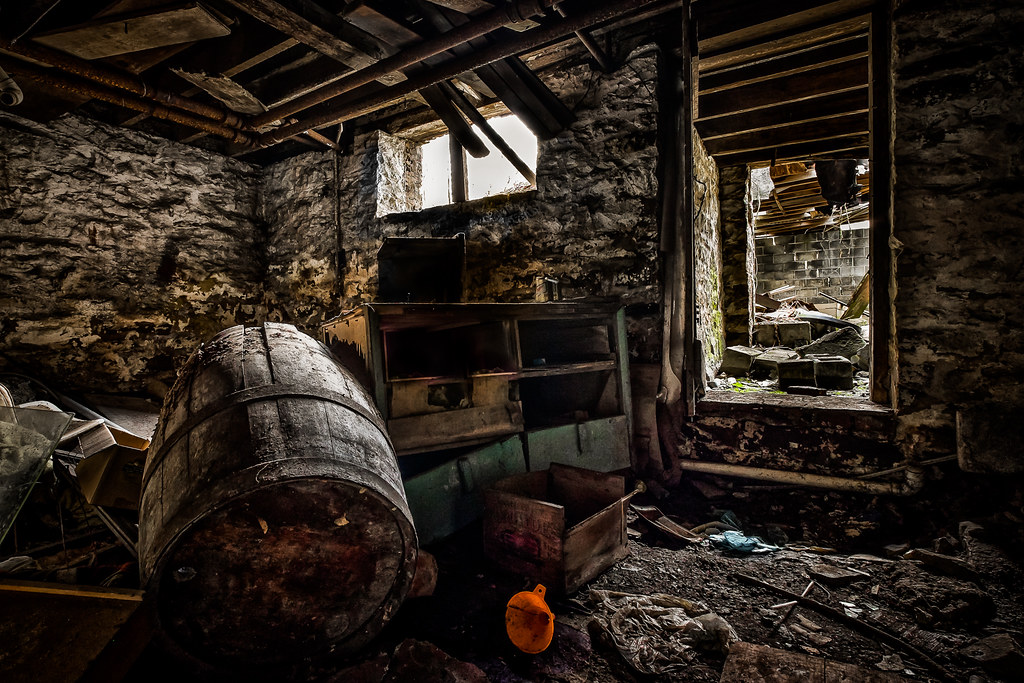
Barrel of Not-So-Fun
The
house had not one but 4 oil tanks that could hold a combined 1000+
gallons of fuel oil. This area is not in a place where you could
expect to get what you needed anytime you needed it back-in-the-day – not with
the kind of winters they have at that altitude.
Moving
up to the first floor (carefully on the rotting treads) one was confronted with
the following scene.
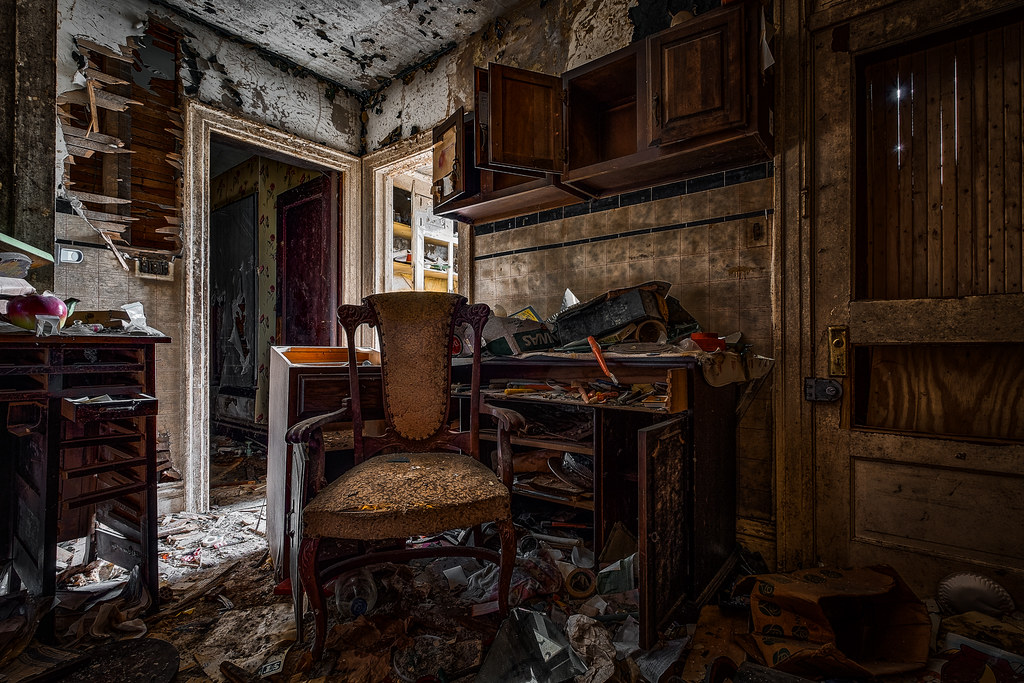
Interview with a Spirit
As
I set up to take this photo in what had clearly been a den, study, or
light workshop; it was almost as if someone was in the chair waiting
to be asked questions. It was a spooky idea but not a frightening
one.
I
noticed a VFW membership card on the desk with the name “Ronald
L. Mathews” on it. As it turned out, that was the fellow who
lived here with his wife who appear in a late portrait below.
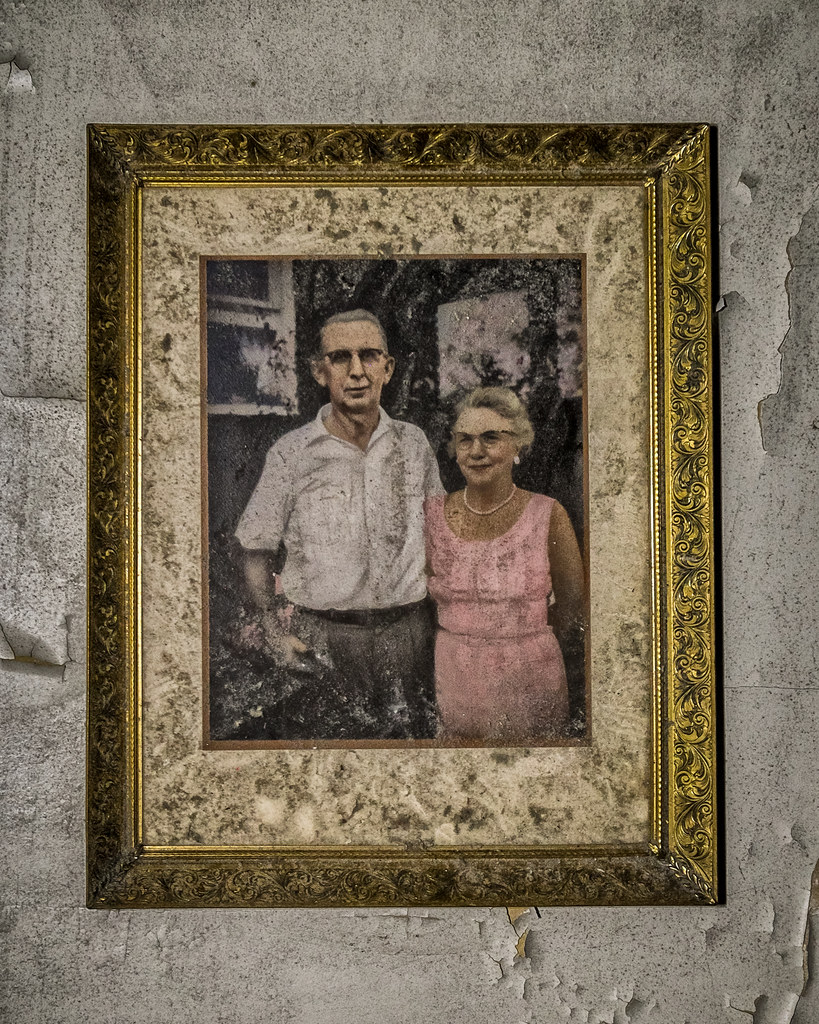
Husband and Wife
Just
beyond this room was the kitchen area with things still in the
cabinets and an incongruously bright umbrella on the floor. I
thought about the old “saving for a rainy day” idea – somehow
this scene seems to illustrate how that day came and went.
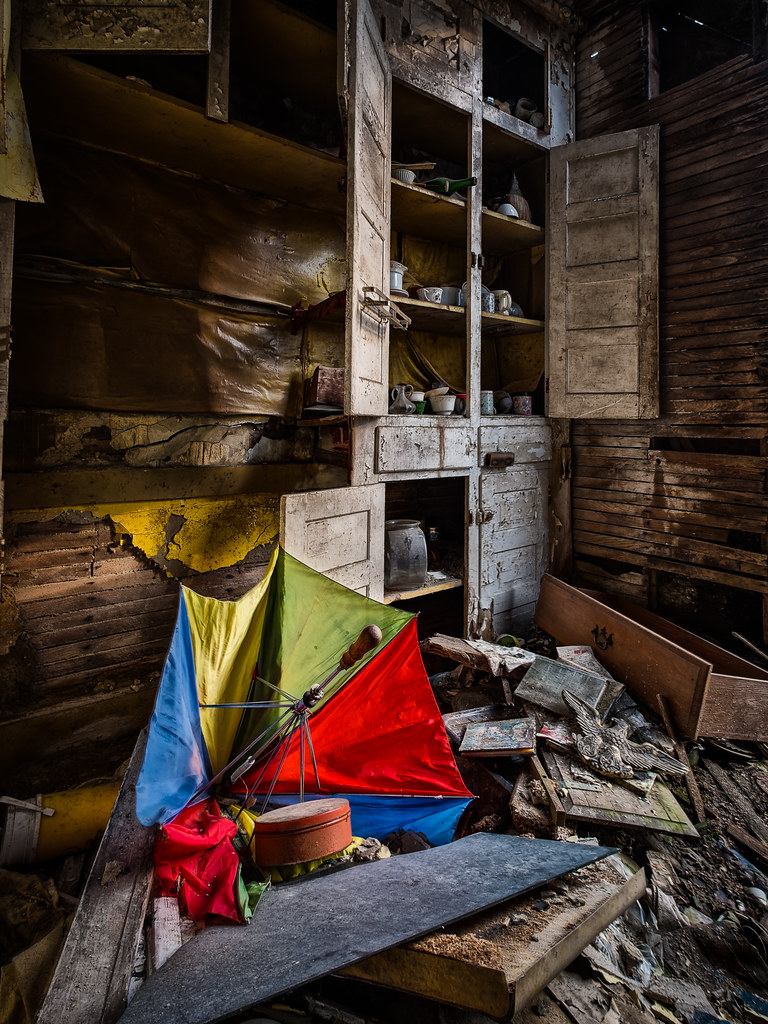
After that Proverbial "Rainy Day"
The
dining room was just a disaster and not really too photogenic even to
my sense of composition. But just beyond the dining room was the
living room with an odd and surprising element in it: dry cleaning,
still in the bag, and hanging on a little rack.
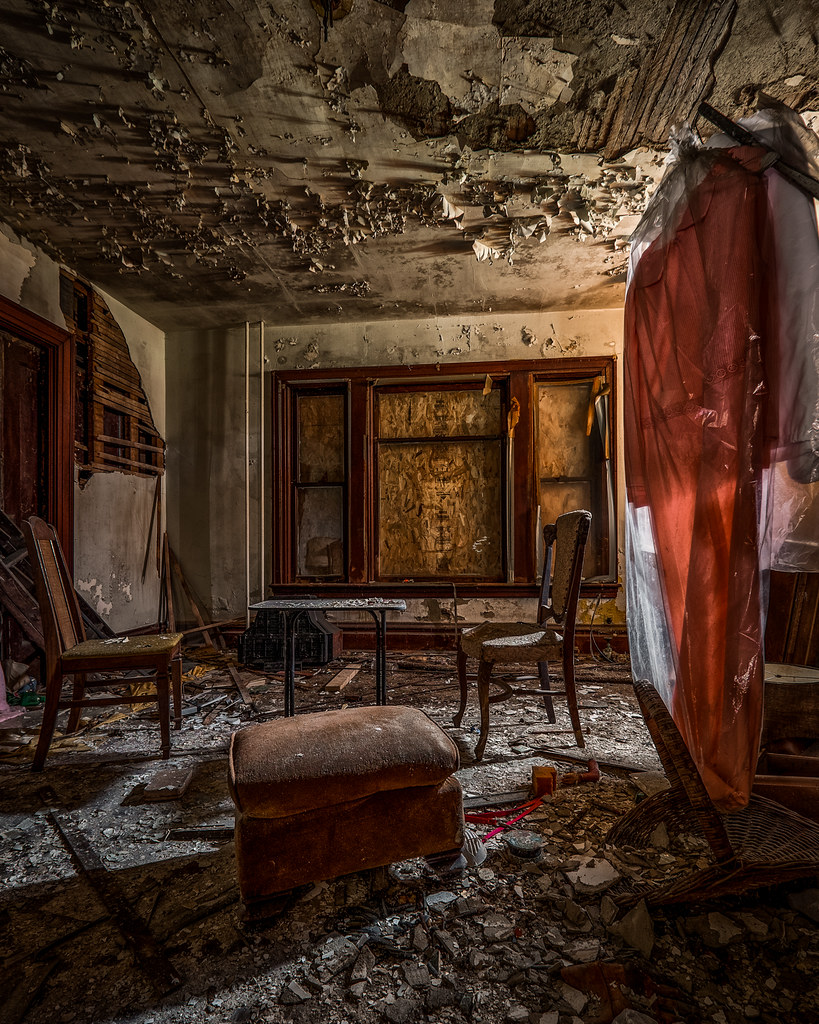
The Last Dry Cleaning
This
item puzzled me no end. First off, it was not destroyed by anyone
and people had clearly come into the place with varying agendas.
Second, how was it just left in the living room to begin with and
why?
A
little digging revealed that the man and his wife lived there up
until the 1990's. She apparently died first – something I had
the other way around as I looked at the scene. An elderly neighbor
from some distance down the road told me a little bit of the family's
story from which I got the order of things straightened out. But
that made the woman's dry cleaning in the living room even more
strange.
I
haven't found the wife's information out, but Ronald Mathews died in
1997 according to a notice I found in the archives of a local
newspaper. His wife had died some years before according to the
neighbor.
As
I was scratching my head over this I showed the picture to a
technician who was working with me. He's from the area and he said
that it was probably some of the clothes that were selected as
possible things for her to be buried in. The funeral home likely
returned the items that were not selected, and Mr. Mathews never had
the heart to do anything with them. One can only presume that he was
more than a little depressed over his wife's passing. There's more
evidence of that as well which I'll show later.
As
far as it still being there unmolested, I think that it was not of
value to anyone, and that it was such a strange sight that it somehow
generated a certain “respect” that caused the vandals to
leave it be.
The Life
Story Builds
Ronald's
birth year can be estimated from a certificate that he was obviously
proud of that was awarded for his penmanship in the 8th
grade in 1937. He was born circa 1924 or 1925 most likely. This put
him at enlistment or draft age during World War II and his military
service was likely done then.
Another
certificate shows that after the war he studied horology (the study
of time – generally involving making timepieces) and received a
degree as a master watchmaker in 1949.
I'll
take this opportunity to remind you that most of the photos here can
be “clicked through” to see higher resolution versions on
my Flickr site.
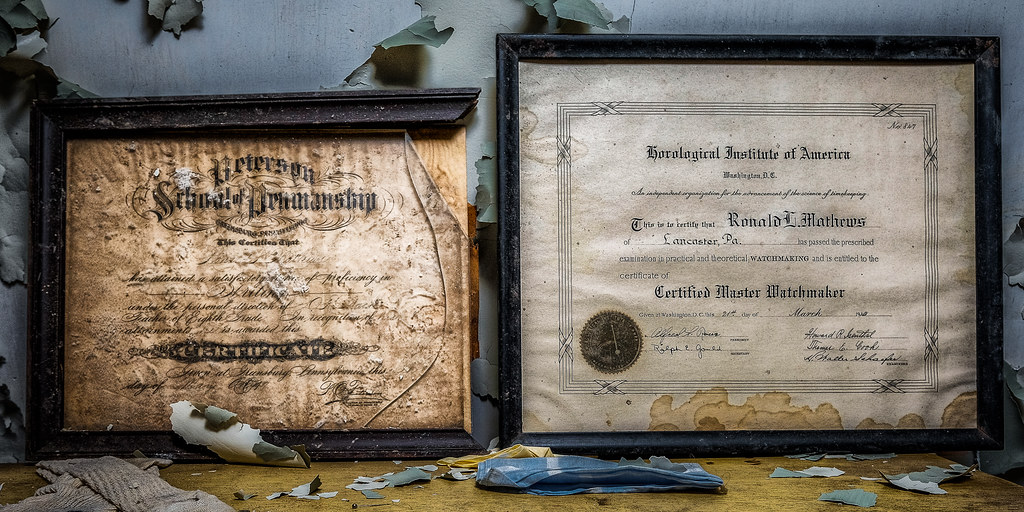
Accomplishment
It
also confirms his age at death was about in his mid 70's.
It's
probably a logical path for a watchmaker to also become a jeweler.
It appears that they had a firm called “Mathews Jewelers”
and later “Mathews Cards & Jewelry” . They sponsored
a ladies bowling league in the 1960's. They won the championship in
the 1965-66 finals.
I
saw that the spelling of the last name on the trophy was wrong.
Perhaps the people who made the trophy simply erred. The official
name of the business was definitely “Mathews” as seen on
other documents there.
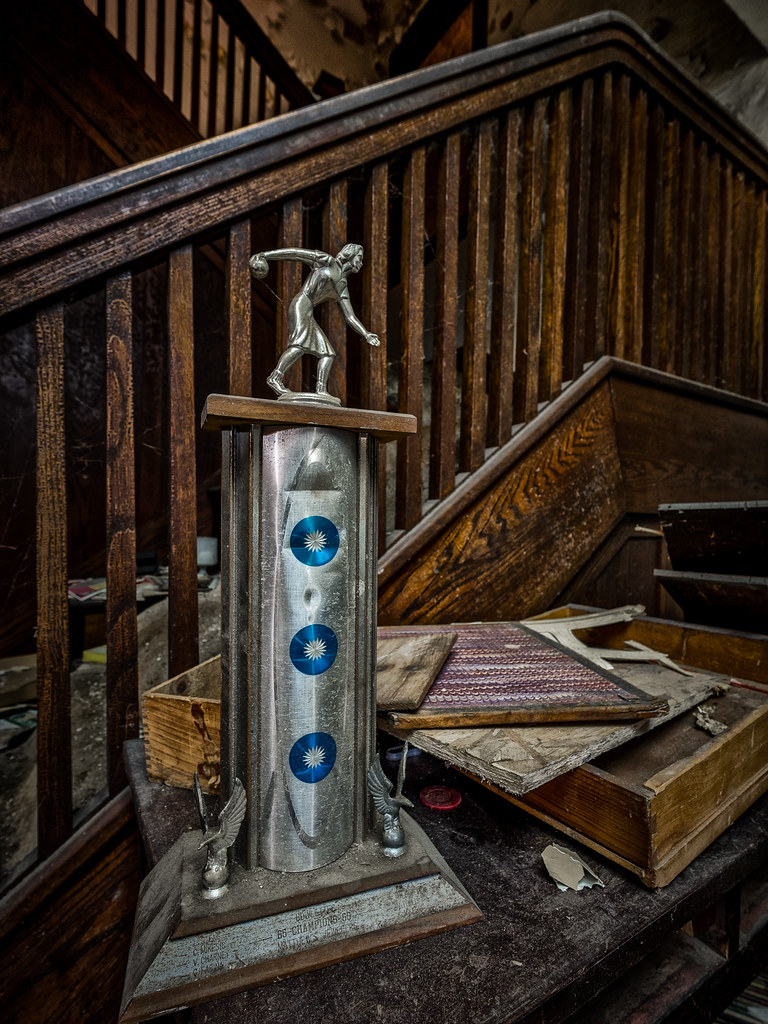
Champion Pride
Upstairs
On
the second floor was the most persuasive evidence that Mr. Mathews was
highly affected by his wife's death. What I found originally had me
thinking that the husband must have died first – as so often
happens.
The
upstairs closets were mostly filled with the wife's clothes, again
undisturbed by the vandals and treasure hunters – although
everything else in closets or rooms has been “tossed”
looking for valuables. The upstairs rooms I mostly didn't photograph
as they were a total mess from being turned inside out by people.
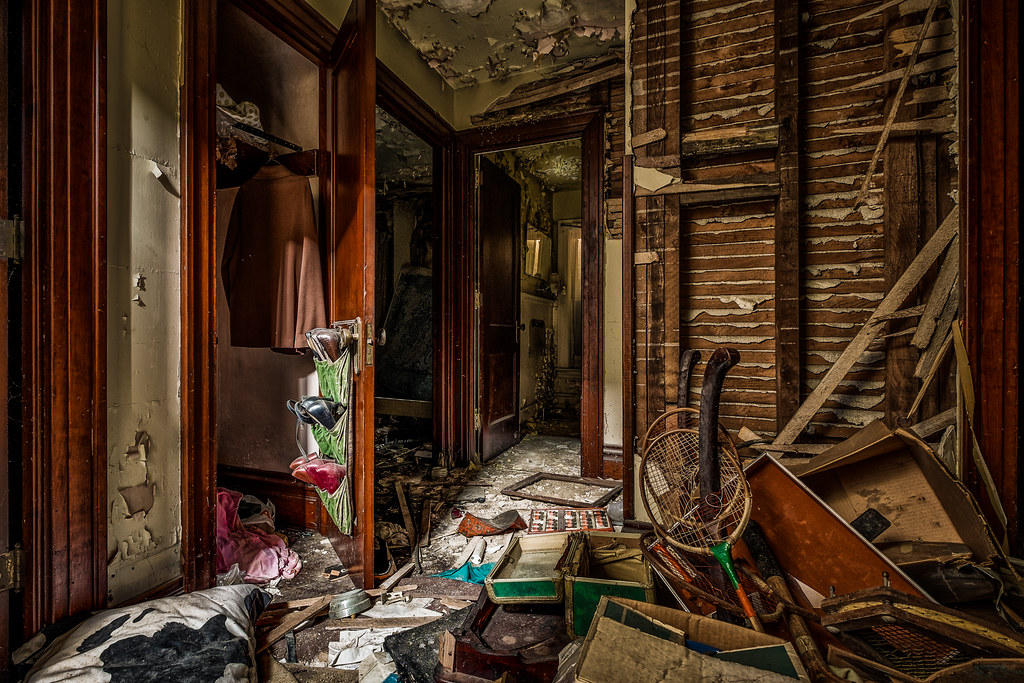
Shoes
I
just find the thought of this man not having the heart to empty any
of the closets of his wife's clothes, or even move the dry cleaning
downstairs, both heart breaking and utterly charming. I can only
hope it was to keep them as a sort of shrine and that he was not too
depressed by his time alone before his own passing.
In
the attic were many things including papers, various old appliances
and lamps, and some old stock from the card store. Mostly things not
worth photographing or perhaps too personal. There was an old Zenith
radio/phonograph at the top of the attic stairs – a quite heavy
piece.
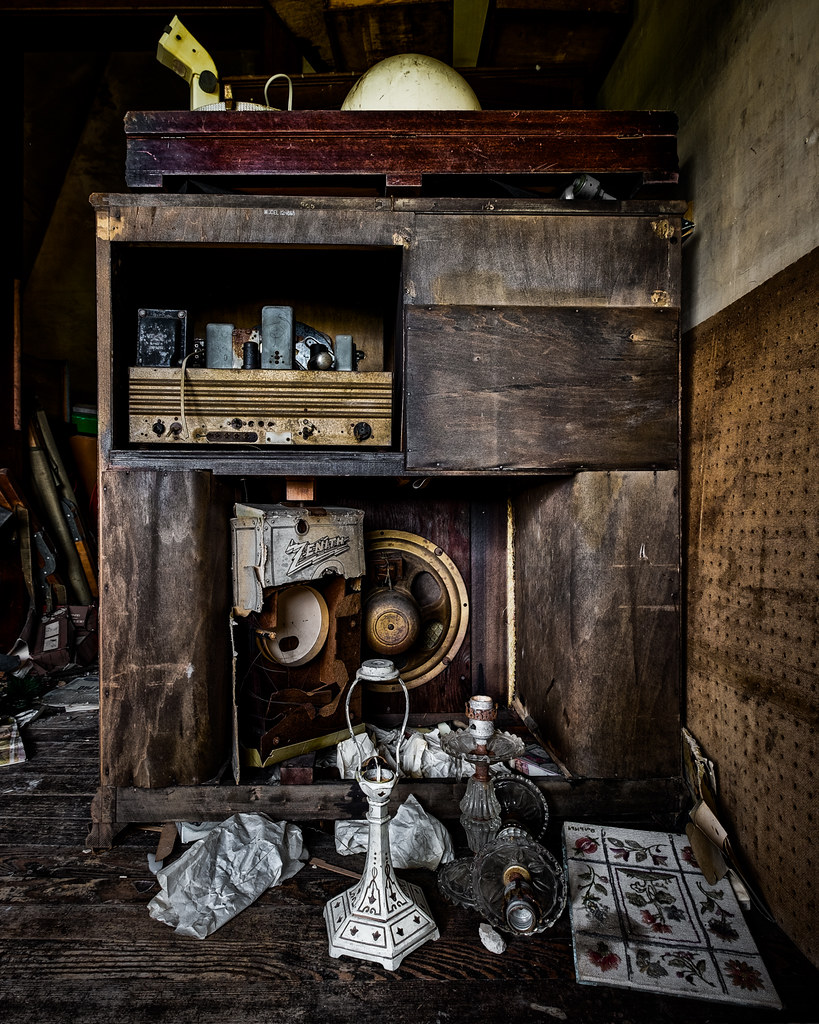
At the Zenith
Final
Thoughts
After
just under two hours in the house, I had already gleaned quite a bit
about who lived there. Normally places like this are empty or so
disturbed that one doesn't learn a lot.
An
elderly neighbor down the road whom I ran across driving to the
pumping station one day (he was walking his dog) told me a little bit
about the place. He was the one who had boarded it up after it was
broken into the first time, though he has not gone back to fix the
door in the basement that was broken in (and was my entry point).
I
told him I'd been in there and what I'd found and he told me that
Ronald and his wife had two boys. After Ronald's death, one of the
sons brought around a trailer and hauled off Ronald's tools and I'm
presuming most of his clothes perhaps. Other than that he left the
house as it was. Both the brothers live hundreds of miles from the house;
one in another state entirely quite far away.
After
the first break-in through the front door, he called one of the
brothers and asked about securing the house and the man said he
didn't care. The neighbor boarded it up at his own expense just
because it seemed the right thing to do. But since then neither
brother has come to inspect or secure the property, and it apparently
hasn't been offered for sale – although the surrounding land
was sold to a pipeline company for a very high price per acre.
He
also told me that my read of the timeline was wrong: that the wife
had died first some years before Ronald – though I didn't learn
how many years before.
Personally,
I find the attitude of the two brothers towards their parents home
where they grew up a little strange and perhaps callous. But I don't
know, and don't need to know, what went on in that family or why
things turned out the way they did. Sometimes as a story starts to
come together you realize it perhaps isn't appropriate to look any
deeper. Maybe what I've done already is not considered appropriate
by some.
But
I do hope the reasons for the observed outcome do not bode ill for anyone
involved and I hope the Mathews rest in peace.
“One
lives in the hope of becoming a memory.” – Antonio
Porchia